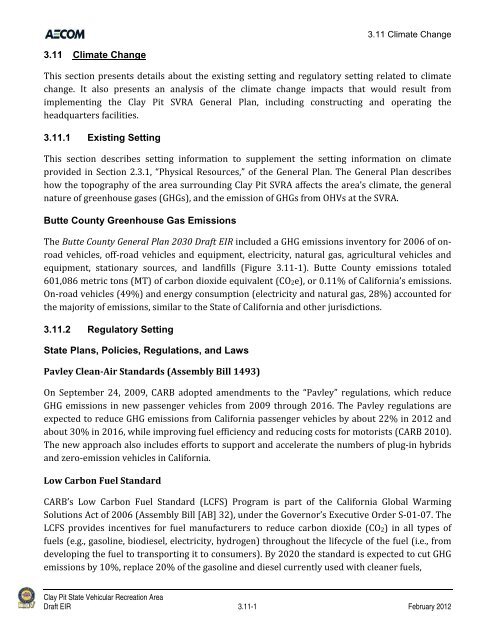Draft Environmental Impact Report - California Off Highway Vehicle ...
Draft Environmental Impact Report - California Off Highway Vehicle ...
Draft Environmental Impact Report - California Off Highway Vehicle ...
Create successful ePaper yourself
Turn your PDF publications into a flip-book with our unique Google optimized e-Paper software.
3.11 Climate Change<br />
3.11 Climate Change<br />
This section presents details about the existing setting and regulatory setting related to climate<br />
change. It also presents an analysis of the climate change impacts that would result from<br />
implementing the Clay Pit SVRA General Plan, including constructing and operating the<br />
headquarters facilities.<br />
3.11.1 Existing Setting<br />
This section describes setting information to supplement the setting information on climate<br />
provided in Section 2.3.1, “Physical Resources,” of the General Plan. The General Plan describes<br />
how the topography of the area surrounding Clay Pit SVRA affects the area’s climate, the general<br />
nature of greenhouse gases (GHGs), and the emission of GHGs from OHVs at the SVRA.<br />
Butte County Greenhouse Gas Emissions<br />
The Butte County General Plan 2030 <strong>Draft</strong> EIR included a GHG emissions inventory for 2006 of on‐<br />
road vehicles, off‐road vehicles and equipment, electricity, natural gas, agricultural vehicles and<br />
equipment, stationary sources, and landfills (Figure 3.11‐1). Butte County emissions totaled<br />
601,086 metric tons (MT) of carbon dioxide equivalent (CO2e), or 0.11% of <strong>California</strong>’s emissions.<br />
On‐road vehicles (49%) and energy consumption (electricity and natural gas, 28%) accounted for<br />
the majority of emissions, similar to the State of <strong>California</strong> and other jurisdictions.<br />
3.11.2 Regulatory Setting<br />
State Plans, Policies, Regulations, and Laws<br />
Pavley CleanAir Standards (Assembly Bill 1493)<br />
On September 24, 2009, CARB adopted amendments to the “Pavley” regulations, which reduce<br />
GHG emissions in new passenger vehicles from 2009 through 2016. The Pavley regulations are<br />
expected to reduce GHG emissions from <strong>California</strong> passenger vehicles by about 22% in 2012 and<br />
about 30% in 2016, while improving fuel efficiency and reducing costs for motorists (CARB 2010).<br />
The new approach also includes efforts to support and accelerate the numbers of plug‐in hybrids<br />
and zero‐emission vehicles in <strong>California</strong>.<br />
Low Carbon Fuel Standard<br />
CARB’s Low Carbon Fuel Standard (LCFS) Program is part of the <strong>California</strong> Global Warming<br />
Solutions Act of 2006 (Assembly Bill [AB] 32), under the Governor’s Executive Order S‐01‐07. The<br />
LCFS provides incentives for fuel manufacturers to reduce carbon dioxide (CO2) in all types of<br />
fuels (e.g., gasoline, biodiesel, electricity, hydrogen) throughout the lifecycle of the fuel (i.e., from<br />
developing the fuel to transporting it to consumers). By 2020 the standard is expected to cut GHG<br />
emissions by 10%, replace 20% of the gasoline and diesel currently used with cleaner fuels,<br />
Clay Pit State Vehicular Recreation Area<br />
<strong>Draft</strong> EIR 3.11-1 February 2012








